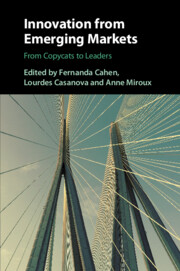Book contents
- Innovation from Emerging Markets
- Innovation from Emerging Markets
- Copyright page
- Contents
- Figures
- Tables
- Boxes
- Contributors
- Foreword
- Acknowledgments
- Introduction
- 1 A Framework for Innovation in Emerging Markets
- Part I Drivers of Innovation in Emerging Markets
- Part II Types of Innovation in Emerging Markets
- 7 The Political Economy of China’s R&D Internationalization
- 8 Emerging Pharmaceutical Companies from China, India, and Brazil
- 9 Reverse Innovation and the Role of Local Partners in Emerging Markets
- 10 Innovation Based on Value Co-creation through Employees at HCL Technologies
- 11 Frugal Innovation in Brazilian Multinationals
- 12 Innovation in War and Peace
- Part III Innovation Outcomes in Emerging Markets
- Conclusions
- Index
- References
9 - Reverse Innovation and the Role of Local Partners in Emerging Markets
The Experience of Foreign Subsidiaries in Brazil
from Part II - Types of Innovation in Emerging Markets
Published online by Cambridge University Press: 15 March 2021
- Innovation from Emerging Markets
- Innovation from Emerging Markets
- Copyright page
- Contents
- Figures
- Tables
- Boxes
- Contributors
- Foreword
- Acknowledgments
- Introduction
- 1 A Framework for Innovation in Emerging Markets
- Part I Drivers of Innovation in Emerging Markets
- Part II Types of Innovation in Emerging Markets
- 7 The Political Economy of China’s R&D Internationalization
- 8 Emerging Pharmaceutical Companies from China, India, and Brazil
- 9 Reverse Innovation and the Role of Local Partners in Emerging Markets
- 10 Innovation Based on Value Co-creation through Employees at HCL Technologies
- 11 Frugal Innovation in Brazilian Multinationals
- 12 Innovation in War and Peace
- Part III Innovation Outcomes in Emerging Markets
- Conclusions
- Index
- References
Summary
The purpose of this chapter is to analyze the relationship of subsidiaries of multinational companies with local partners. The focus is on MNCs from advanced markets and their influence on the development of reverse innovations in emerging markets. Unlike the regular flow, reverse innovations consist of the development of new products, processes, and services created initially to meet the local demands of EMs, but that are later understood as fundamental by the multinational for generating gains of global competitive advantage, only to be disseminated to the headquarters and applied in developed markets. Through the use of statistical techniques in 113 subsidiaries of foreign multinationals operating in Brazil, we found that the quality of the relationship with local partners is significant, as it offers subsidiaries access to both local resources and the knowledge acquired by local partners. In addition, we found that innovations developed by subsidiaries were not restricted to them, thanks to the gains in competitive advantage they provide to headquarters and other units operating in developed markets. Finally, we point out that it is not only subsidiaries but also local partners who enjoy gains from such access, an indication of the strategic importance of quality relationships between local partners and subsidiaries in emerging markets for competitive gains on both ends.
- Type
- Chapter
- Information
- Innovation from Emerging MarketsFrom Copycats to Leaders, pp. 256 - 277Publisher: Cambridge University PressPrint publication year: 2021

